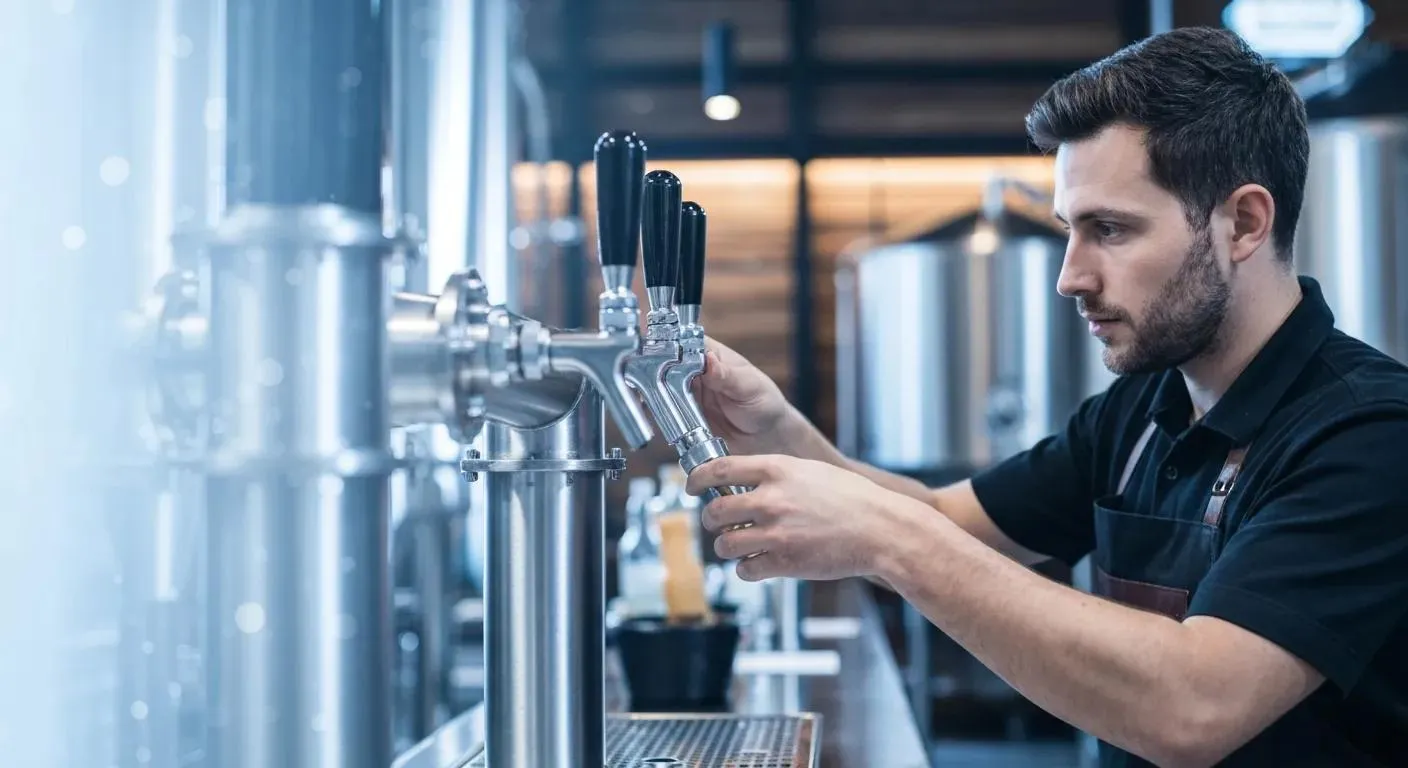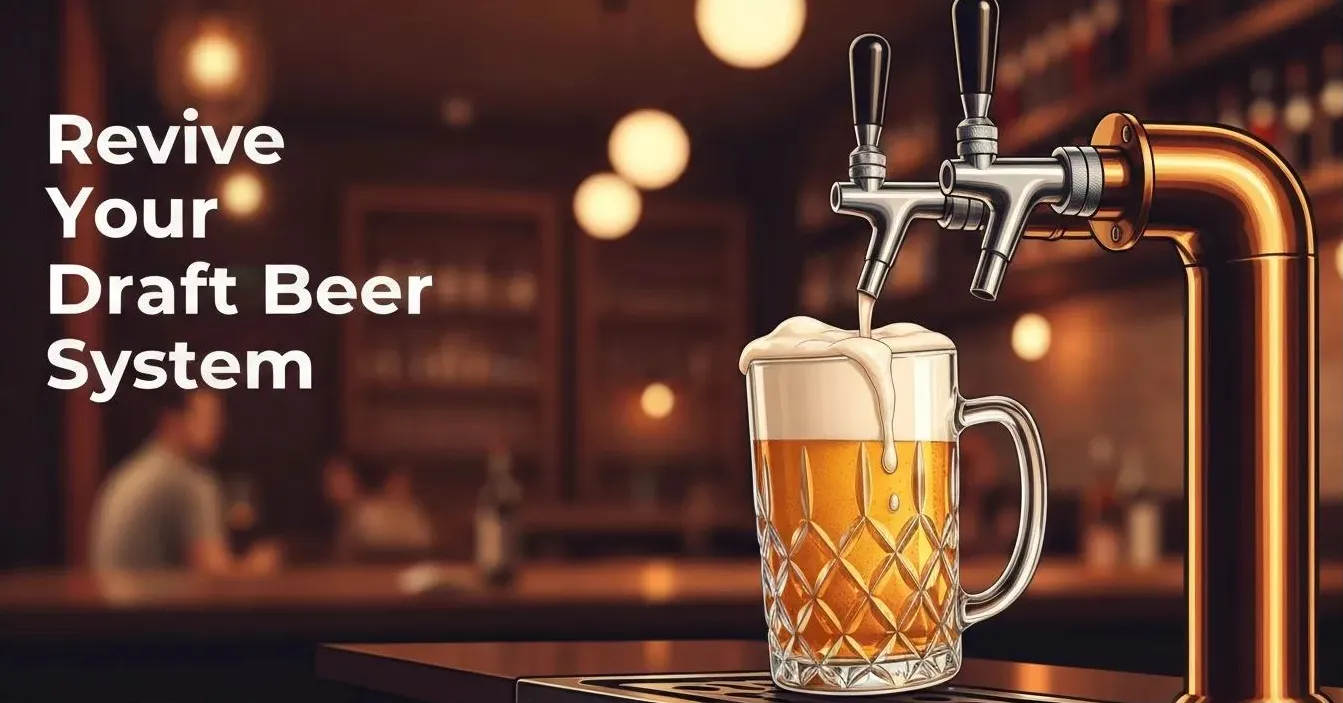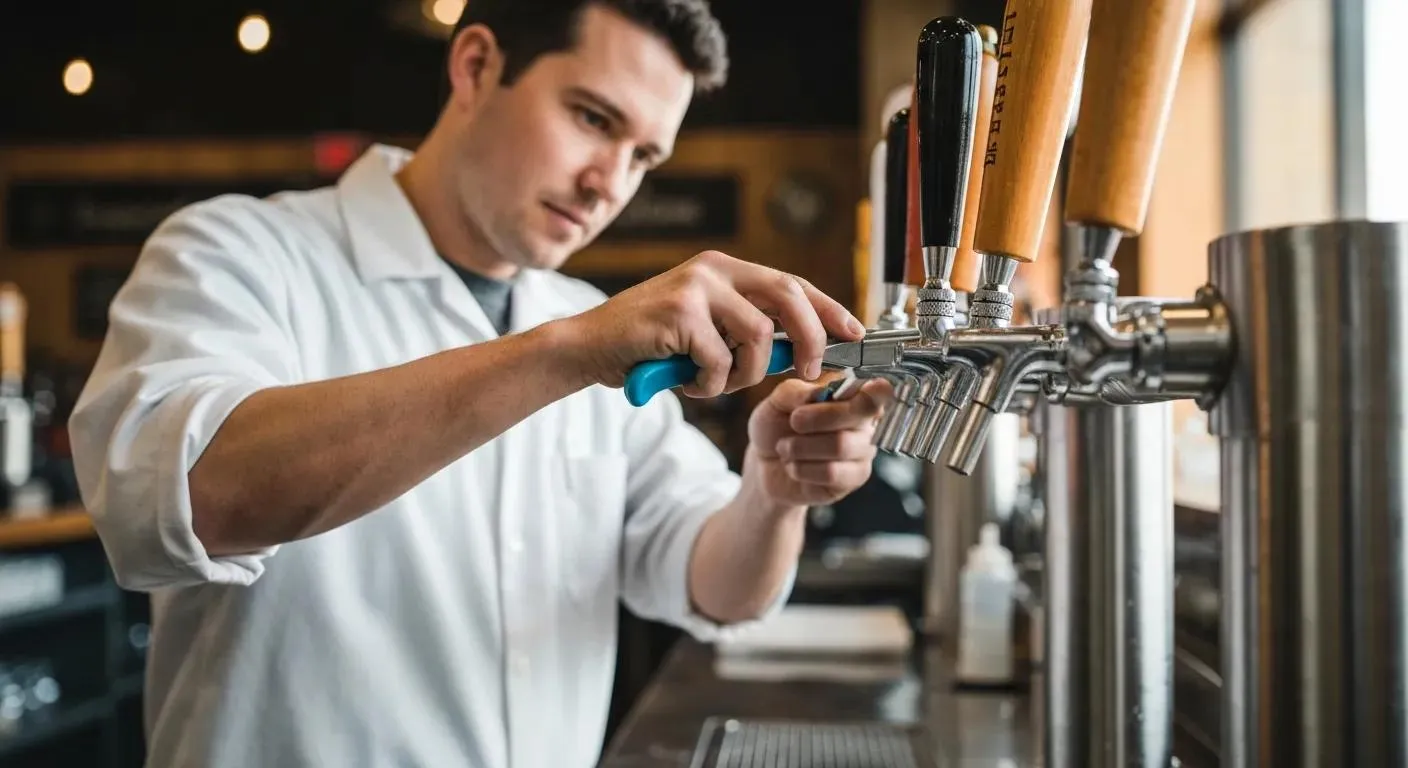Glycol Beer System: The Ultimate Guide to Temperature Control in Draft Beer Dispensing

A glycol beer system is a popular choice for bars and restaurants that want to serve cold beer. This system uses glycol, a food-grade antifreeze, to keep beer at the proper temperature for dispensing. The glycol is combined with water to create a chilled mixture, called a glycol bath, which is then pumped through cooling lines that run parallel to the beer lines in a beer trunkline. By chilling the liquid glycol and pumping it into lines the beer is chilled and maintained with the temperature in the walk-in cooler.
One of the main advantages of a glycol system is that it allows bars and restaurants to serve beer from kegs that are located far away from the tap. This is because the glycol can be chilled to a lower temperature than beer, which means that it can be used to transport beer over longer distances without affecting its quality. However, it is important to note that remote beer systems can be more expensive to install and maintain than other types of beer dispensing systems. This is because they require additional equipment, such as a glycol chiller and cooling lines, which can add to the overall cost of the system.
Despite these costs, many bars and restaurants choose these beer systems for their ability to serve cold, high-quality beer over long distances. Let's dive in.
Understanding Glycol Beer Systems
Glycol beer systems are a popular type of draft beer system used in bars, restaurants, and other establishments that serve beer. These systems use a mixture of glycol and water to cool beer as it travels from the keg to the tap. Glycol is commonly used in refrigeration systems.
The glycol cooling system consists of a glycol chiller, a trunk line, and cooling lines. The glycol chiller is a refrigeration unit that contains a mixture of glycol and water. The trunk line is an insulated line that runs from the glycol chiller to the tap tower.
The glycol chiller system works by pumping the glycol mixture from the chiller through the trunk line and cooling lines. As the glycol mixture travels through the cooling lines, it absorbs heat from the beer, keeping it at the proper temperature for dispensing. The cold glycol mixture then returns to the chiller to be cooled again.
One of the main advantages of a remote beer system is that it allows beer to be served at a consistent temperature, even if the kegs are located far away from the tap. This makes it ideal for long-draw systems, where the kegs are located in a remote location.
Glycol systems are also easy to install and maintain. They require minimal space and can be customized to fit the needs of any establishment. Additionally, glycol is a non-toxic and safe to use with beer.
Components of Glycol Beer Systems
10 Key Elements of a Glycol Beer System
Remote beer systems are long-draw beer systems that use a mixture of glycol and water to keep beer at a consistent temperature as it travels from keg to tap. These systems consist of several components that work together to ensure that beer is dispensed at the ideal temperature. Below are the main components of a remote beer system:
Glycol Chiller
The glycol chiller is the heart of the beer system. It is a refrigeration unit that pumps a mixture of glycol and water through a trunk line to keep the beer at a consistent temperature. The glycol chiller contains a compressor, evaporator fan, and a thermostat to regulate the temperature. It also has a glycol reservoir with a coil or plate chiller that contains cooling refrigerant.

Beer F.O.B
A beer fob, short for "foam on beer," is a device typically installed on the beer dispensing system, usually between the keg and the faucet, and works by ensuring that only liquid beer, and not excess air or foam, is dispensed when a customer orders a pint. The FOB protects the trunk line so that it stays filled with beer when a keg gets cashed.

Beer Lines/Air Lines
Beer lines and air lines are the tubes that transport beer and gas from the keg to the tap. The lines are made of food-grade tubing. Air lines are used to transport CO2 or nitrogen gas from the regulator to the keg. These are typically in red line or high pressure braided tubing.
Secondary Regulators
Secondary regulators are used to control the pressure of the gas that is used to push the beer out of the keg. They are typically used when multiple beers are being served. Each beer will have its own secondary regulator to ensure that the pressure is correct for that particular beer.
Primary Regulator
The primary regulator is used to control the pressure of the gas that is used to push the beer out of the keg. It is typically used when only one beer is being served from the keg.

Draft Beer Tower
The beer tower is the part of the system that dispenses the beer. It is typically made of stainless steel or brass and contains one or more faucets. These beer towers come in a variety of shapes and sizes.
Keg Couplers
Keg couplers are used to connect the vinyl lines to the keg. They come in different types depending on the type of keg being used, or beer being served.
Nitrogen Generator-Green Air Supply
A nitrogen generator-green air supply is used to generate nitrogen gas that is used to push the beer out of the keg. It is typically used when serving nitrogenated beers like stouts or porters. Also, used to push beers over distances without using beer pumps.

Beer Trunk Line
The beer trunk line is the tube that transports beer from the glycol chiller and walk in cooler to the draft tower. It is typically made of insulated tubing and is buried in ice to keep the beer at a consistent temperature.

Why Glycol?
https://www.youtube.com/watch?v=Tm0Qxp1pJKY&embed=true
Glycol is a necessary component in the operation of a remote beer system. The glycol mixture is used as a cooling agent to maintain a consistent temperature throughout the system. Glycol is also used as a refrigerant in the system and can help to prevent temperature fluctuations.
Propylene glycol is a commonly used glycol mixture that has a freezing point of around -60 degrees Fahrenheit. This makes it an ideal choice for use in glycol line cooling systems, as it can help to maintain a cold temperature even in warm environments.
Glycol cooling systems work by circulating a glycol bath through a series of pipes that run throughout the system. The glycol bath is cooled by a glycol chiller system, which uses a refrigeration unit to cool the glycol mixture. As the glycol bath circulates through the system, it helps to maintain a consistent temperature throughout the system.
One of the key benefits of using glycol as a cooling agent is its ability to maintain a consistent temperature. This is especially important in a draft beer system, where temperature fluctuations can have a significant impact on the quality of the beer. By using glycol as a cooling agent, bars and restaurants can ensure that their beer is served at a consistent temperature, which helps to maintain its quality and taste. From walk in cooler to the dispensing tower.
Overall, glycol is a critical component in the operation of draft beer. Chilled glycol is used as a cooling agent to maintain a consistent temperature throughout the system and can help to prevent temperature fluctuations.
Benefits of Glycol Beer Systems
https://www.youtube.com/watch?v=jM5ZSktpIuU&embed=true
Serving beer on remote beer systems are a popular choice for bars and pubs that want to dispense beer away from their beer cooler. This type of draft beer system allows users to dispense beer ready to drink up to 500 feet away, which is ideal for establishments that have multiple bar stations. The glycol system also allows users to dispense beer at many bar stations while using one consolidated beer cooler.

These beer systems are also highly efficient and economical. They use a glycol cooling system that is designed to keep the beer at the right temperature, which eliminates the need for additional refrigeration units. This not only saves space but also reduces the overall energy consumption of the establishment.
Overall, remote beer systems offer excellent performance and benefits for draft beer systems. They are a reliable and efficient way to dispense beer, and they help maintain the quality of the beer while also reducing energy consumption and saving money.
Maintaining a Remote Beer System
Regular maintenance of all parts of the glycol dispensing system is essential to prevent issues such as clogging, leaks, and contamination. The glycol power pack, glycol trunk line, the bath, the hardware, and the glycol itself should be checked regularly to ensure that they are in good condition and functioning correctly. Any issues should be addressed promptly to prevent further damage to the system.
Cleaning a remote draft beer system is also a critical aspect of maintenance. The system should be cleaned every 14 days to prevent the buildup of bacteria and other contaminants that can affect the taste and quality of the beer. The cleaning process involves flushing the system with a cleaning solution, followed by a rinse with clean water.

The ideal temperature for serving cold beer is 38°F. Temperature fluctuations can be caused by a variety of factors, including changes in room temperature, dirty lines, and clogged glycol lines. Regular maintenance and cleaning can help prevent these issues and ensure that the beer is consistently served at the optimal temperature.
Frequently Asked Questions
What is a Glycol Beer System?
A glycol beer system is a cooling system used to keep beer at a constant temperature from the keg to the tap. It works by circulating a mixture of glycol and water through a series of tubes that run alongside the beer lines. The glycol mixture is cooled by a refrigeration unit and then circulated through the tubes, keeping the trunk lines and the beer at the desired temperature.
How Much Does a Glycol Beer System Cost?
The cost of a glycol beer system varies depending on the size and complexity of the system. A basic system for a bar can cost anywhere from $1,500 to $5,500, while a large commercial system can cost several thousand dollars or more.
How Does a Glycol System Work?
A glycol keg system works by circulating a mixture of glycol and water through a series of tubes that run alongside the beer lines. The glycol mixture is cooled by a refrigeration unit and then circulated through the tubes, keeping the beer lines and the beer at the desired temperature. The glycol mixture is then returned to the refrigeration unit to be cooled again.
What Type of Glycol is Used In a Beer Chiller?
Manufacturers recommend using USP grade propylene glycol in beer chillers. This type of glycol is food grade and safe for consumption.
What Is The Ideal Temperature For a Glycol Beer System?
The ideal temperature for a glycol beer system is between 27-29 °F . This temperature range ensures that the beer is kept at the optimal temperature for serving.
Conclusion
Glycol beer systems are an essential component of long draw or commercial draft beer systems. These systems implement a chiller that uses the power of glycol to keep beer at the ideal temperature range of 38 °F.
One of the primary benefits of using a glycol beer system is that it allows for longer beer lines, which means more beer can be stored in a cooler location. Additionally, glycol systems are more efficient than other cooling methods, which can save money on energy costs.
However, like any system, glycol beer systems require regular maintenance to ensure that they are working correctly. This includes checking glycol levels, cleaning lines and taps, and checking for leaks. Proper maintenance will help to ensure that the system continues to function correctly and that the beer is served at the ideal temperature.
Overall, glycol beer systems are an excellent choice for anyone looking to serve draft beer, especially in a commercial setting. They offer many benefits, including longer beer lines and increased efficiency, and with proper maintenance, they can provide reliable service for years to come.
For anymore questions please contact us. And I recommend checking out the rest of our blog on beer education.
Cheers!



